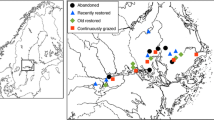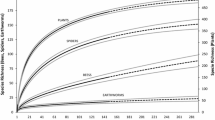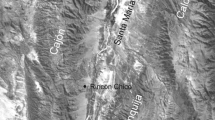Abstract
A characteristic group of obligatory weeds was found in the well of the submerged Pre-Pottery Neolithic C site of Atlit-Yam, Israel. Identifying these finds to species level was crucial for defining them as obligatory weeds. We deal here with the earliest and largest assemblage of obligatory and facultative weeds in the southwest Asian Neolithic. Atlit-Yam may reflect a stage in the establishment of weeds in cultivated fields. Weeds are an important resource for reconstructing the agricultural situation in archaeological sites, as weed-crop interactions reflect an agricultural lifestyle. Some of the weeds of Atlit-Yam grow in fields as well as in Mediterranean herbaceous habitats. This may indicate that the local herbaceous ecosystem was the original habitat of the weeds and the place where the first fields were planted. Presence in a single context of the earliest identified obligatory grain pest beetle (Sitophilus granarius) along with obligatory weeds reflects a novel change made to the ecosystem by the farmers, in which stored crops were invaded by pests.







Similar content being viewed by others
References
Bar-Matthews M, Ayalon A, Kaufman A (1997) Late Quaternary paleoclimate in the eastern Mediterranean region from stable isotope analysis of speleothems at Soreq cave, Israel. Quat Res 47:155–168
Bor NL (1968) Lolium L. In: Townsend CC, Guest E, Al-Rawi A (eds) Flora of Iraq. Iraq Ministry of Agriculture, Baghdad, pp 90–99
Colledge S (1998) Identifying pre-domestication cultivation using multivariate analysis. In: Damania A, Valkoun J, Willcox G, Qualset CO (eds) The origins of agriculture and crop domestication. ICARDA, Aleppo, pp 121–131
Dafni A (1984) Edible wild plants of Israel. Society for the Protection of Nature in Israel, Jerusalem
Damania AB, Valkoun J, Willcox G, Qualset CO (1998) The origins of agriculture and crop domestication, 1st Harlan symposium. ICARDA, Aleppo
Danin A (2004) Distribution atlas of plants in the Flora Palaestina area. Israel Academy for Science and Humanities, Jerusalem
De Moulins D (2000) Abu Hureyra 2: plant remains from the Neolithic. In: Moore AMT, Hillman GC, Legge AJ (eds) Village on the Euphrates: from foraging to farming at Abu Hureyra. Oxford University Press, New York, pp 399–416
Dobie P, Haines CP, Hodgers RJ, Prevett PF, Rees DP (1991) Insects and arachnids of tropical stored products: their biology and identification. Revised by Haines CP, 2nd edn. NRI, Slough
Eliáš P, Hajnalová M, Eliasova M (2010) Historical and current distribution of segetal weed Lolium temulentum L. in Slovakia. Hacquetia 9:151–159
Fahmy AG (1997) Evaluation of the weed flora of Egypt from Predynastic to Graeco-Roman times. Veget Hist Archaeobot 6:241–247
Fairbairn A, Martinoli D, Butler A, Hillman G (2007) Wild plant seed storage at Neolithic Çatalhöyük East, Turkey. Veget Hist Archaeobot 16:467–479
Feinbrun-Dothan N (1978) Flora Palaestina, vol 3. Israel Academy of Sciences and Humanities, Jerusalem
Feinbrun-Dothan N (1986) Flora Palaestina, vol 4. Israel Academy of Sciences and Humanities, Jerusalem
Feinbrun-Dothan N, Danin A (1998) Analytical flora of Eretz-Israel. Cana, Jerusalem
Fragman-Sapir O, Plitmann U, Heller D, Shmida A (1999) Checklist and ecological data-base of the flora of Israel and its surroundings. Miflalot “Yeffe Nof” & The Middle East Nature conservation promotion association, Jerusalem
Fuller D (2007) Contrasting patterns in crop domestication and domestication rates: recent archaeobotanical insights from the Old World. Ann Bot 100:903–924
Galili E, Nir Y (1993) The submerged Pre-Pottery Neolithic water well of Atlit-Yam, northern Israel, and its palaeoenvironmental implications. Holocene 3:265–270
Galili E, Rosen B (2011) Submerged Neolithic settlements off the Mediterranean coast of Israel. In: Benjamin J, Bonsall C, Pickard C, Fischer A (eds) Submerged prehistory. Oxbow Books, Oxford, pp 272–286
Galili E, Weinstein-Evron M, Hershkovitz I, Gopher A, Kislev M, Lernau O, Kolska-Horwitz L, Lernau H (1993) Atlit-Yam: a prehistoric site on the sea floor off the Israeli coast. J Field Archaeol 20:133–157
Garfinkel Y, Kislev M, Zohary D (1988) Lentil in the Pre-Pottery Neolithic B Yiftah’el: additional evidence of its early domestication. Isr J Bot 37:49–51
Greig JRA (1990) Practical ecology: experiments in growing traditional cornfield weeds and a comment on their archaeological records in Britain. In: Robinson DE (ed) Experimentation and reconstruction in environmental archaeology. (Symposia of the Association for Environmental Archaeology 9). Oxbow, Oxford, pp 41–62
Harlan JR (1965) The possible role of weed races in the evolution of cultivated plants. Euphytica 14:173–176
Harlan JR (1995) The living fields. Cambridge University Press, Cambridge
Harlan JR, DeWet JMJ (1965) Some thoughts about weeds. Econ Bot 19:16–24
Helbæk H (1969) Plant collecting, dry-farming, and irrigation agriculture in prehistoric Deh Luran. In: Hole F, Neely JA, Flannery KV, Helbæk H (eds) Prehistory and human ecology of the Deh Luran Plain. Memoirs of the Museum of Anthropology, University of Michigan, Ann Arbor, pp 383–428
Helbæk H (1970) The plant husbandry of Hacılar. In: Mellaart J (ed) Excavations at Hacılar. Edinburgh University Press, Edinburgh, pp 189–244
Hillman GC (1972) Plant remains. In: French DH, Hillman GC, Payne S, Payne RJ, Excavations at Can Hasan III 1969–1970. In: Higgs ES (ed) Papers in economic prehistory. Cambridge University Press, Cambridge, pp 182–188
Hillman GC (1978) On the origin of domestic rye—Secale cereale: the finds from aceramic Can Hasan III in Turkey. Anatol Stud 28:157–174
Hillman GC (1991) Phytosociology and ancient weed floras: taking account of taphonomy and changes in cultivation methods. In: Harris DR, Thomas KD (eds) Modelling ecological change. Institute of Archaeology, University College London, London, pp 27–40
Howe RW (1965) A summary of estimates of optimal and minimal conditions for population increase of some stored products insects. J Stored Prod Res 1:177–184
Jones G (2002) Weed ecology as a method for the archaeobotanical recognition of crop husbandry practices. Acta Palaeobot 42:185–193
Jones G, Charles M, Bogaard A, Hodgson J (2010) Crops and weeds: the role of weed functional types in the identification of crop husbandry methods. J Archaeol Sci 37:70–77
Kislev ME (1997) Early agriculture and paleoecology of Netiv Hagdud. In: Bar-Yosef O, Gopher A (eds) An early Neolithic village in the Jordan valley, Part I: the archaeology of Netiv Hagdud. Peabody Museum of Archaeology and Ethnology, Harvard University, Cambridge, pp 209–236
Kislev ME, Hartmann A, Galili E (2004) Archaeobotanical and archaeoentomological evidence from a well at Atlit-Yam indicates colder, more humid climate on the Israeli coast during the PPNC period. J Archaeol Sci 31:1301–1310
Kreuz A, Schäfer E (2011) Weed finds as indicators for the cultivation regime of the early Neolithic Bandkeramik culture? Veget Hist Archaeobot 20:333–348
Kreuz A, Marinova E, Schäfer E, Wiethold J (2005) A comparison of early Neolithic crop and weed assemblages from the Linearbandkeramik and the Bulgarian Neolithic cultures: differences and similarities. Veget Hist Archaeobot 14:237–258
Neef R (2003) Overlooking the steppe forest: a preliminary report on the botanical remains from early Neolithic Göbekli Tepe (southern Turkey). Neo-lithics 2:13–16
Pasternak R (1998) Investigations of botanical remains from Nevali Çori PPNB, Turkey – A short interim report. In: Damania AB, Valkoun J, Willcox G, Qualset CO (eds) The origins of agriculture and crop domestication, 1st Harlan symposium. ICARDA, Aleppo, pp 170–177
Pieters AJ (1935) What is a weed? J Am Soc Agron 27:781–783
Riehl S, Zeidi M, Conard NJ (2013) Emergence of agriculture in the foothills of the Zagros Mountains of Iran. Science 341:65–67
Savard M, Nesbitt M, Gale R (2003) Archaeobotanical evidence for Neolithic diet and subsistence at M’lefaat (Iraq). Paléorient 29:93–106
Van Zeist W, De Roller GJ (2003a) Some notes on the plant husbandry of Aşikli Höyük. In: Van Zeist W (ed) Reports on archaeobotanical studies in the Old World. The Groningen Institute of Archaeology, University of Groningen, Groningen, pp 115–142
Van Zeist W, De Roller GJ (2003b) The Çayönü archaeobotanical record. In: Van Zeist W (ed) Reports on archaeobotanical studies in the Old World. The Groningen Institute of Archaeology, University of Groningen, Groningen, pp 143–166
Van Zeist W, Bakker-Heeres JAH [1982 (1985)] Archaeobotanical studies in the Levant, 1. Neolithic Sites in the Damascus Basin: Aswad, Ghoraifé, Ramad. Palaeohistoria 24:165–256
Van Zeist W, Bakker-Heeres JAH [1984 (1986)] Archaeobotanical studies in the Levant, 3. Late-Palaeolithic Mureybit. Palaeohistoria 26:171–199
Van Zeist W, Waterbolk-Van Rooijen W (1985) The palaeobotany of Tell Bouqras, eastern Syria. Paléorient 11:131–147
Vavilov NI (1949–1950) Phytogeographic basis of plant breeding. In: Vavilov NI (ed) The origin, variation, immunity, and breeding of cultivated plants. Chronica Botanica. Mass., Waltham, pp 46–54
Vavilov NI (1987) Origin and geography of cultivated plants. Cambridge University Press, Cambridge
Wasylikova K (1981) The role of fossil weeds for the study of former agriculture. Zeit Arch 15:11–23
Webster Third New International Dictionary (1966) GC Merriam Company. Springfield, Massachusetts
Willcox G (2001) Présence des Céréales dans le Néolithique Préceramique de Shillourokambos à Chypre. Paléorient 26:129–135
Willcox G (2008) Nouvelles données archéobotaniques de Mureybet et la néolithisation du moyen Euphrate. In: Ibañez J (ed) Le site néolithique de Tell Mureybet (Syrie du Nord), en hommage à Jacques Cauvin. (BAR International Series 1843). Archaeopress, Oxford, pp 103–114
Willcox G (2012) Searching for the origins of arable weeds in the Near East. Veget Hist Archaeobot 21:163–167
Willcox G, Herveux L (2013) Late Pleistocene/early Holocene charred plant remains: preliminary report. In: Mazurowski RF, Kanjou Y (eds) Tell Qaramel 1999–2007. Protoneolithic and early Pre-Pottery Neolithic settlement in northern Syria. PCMA, Warsaw, pp 120–130
Willcox G, Fornite S, Herveux L (2008) Early Holocene cultivation before domestication in northern Syria. Veget Hist Archaeobot 17:313–325
Zohary M (1941) The weeds of Palestine and their control. Hassadeh, Tel-Aviv (in Hebrew)
Zohary M (1950) The segetal plant communities of Palestine. Plant Ecol 2:387–411
Zohary M (1962) Plant life of Palestine. Ronald Press, New York
Zohary M (1966) Flora Palaestina, vol 1. Israel Academy of Sciences and Humanities, Jerusalem
Zohary M (1972) Flora Palaestina, vol 2. Israel Academy of Sciences and Humanities, Jerusalem
Zohary D (2004) Unconscious selection and the evolution of domesticated plants. Econ Bot 58:5–10
Zohary D, Hopf M, Weiss E (2012) Domestication of plants in the old world, 4th edn. University Press, Oxford
Acknowledgments
We would like to thank E. Donahaye of the Department of Plant Protection, Beit-Dagan, Israel, for confirming the identification of S. granarius; J. Langsam for the SEM micrographs; Y. Mahler-Slasky for the stereo-microscope pictures and we thank the anonymous reviewers for their constructive comments. We also thank the COST program, action TD0902, SPLASHCOS of the European Commission, the National Geographic Research Foundation, CARE Archaeological Foundation, MAFCAF Foundation, and Sandy and Joseph Lepelstat for their financial support of research on the submerged Carmel coast sites. The Israel Antiquities Authority, the Israel Prehistoric Society and Haifa University are acknowledged for their financial and administrative support of the underwater excavations.
Author information
Authors and Affiliations
Corresponding author
Additional information
Communicated by F. Bittmann.
Rights and permissions
About this article
Cite this article
Hartmann-Shenkman, A., Kislev, M.E., Galili, E. et al. Invading a new niche: obligatory weeds at Neolithic Atlit-Yam, Israel. Veget Hist Archaeobot 24, 9–18 (2015). https://doi.org/10.1007/s00334-014-0498-3
Received:
Accepted:
Published:
Issue Date:
DOI: https://doi.org/10.1007/s00334-014-0498-3




